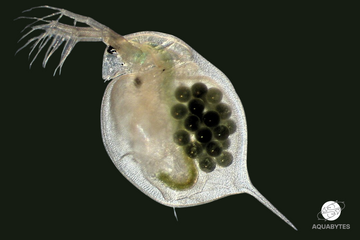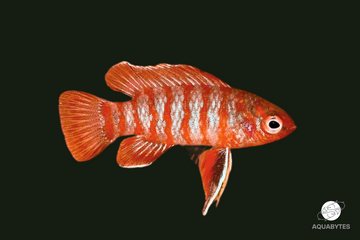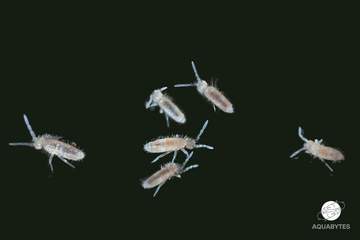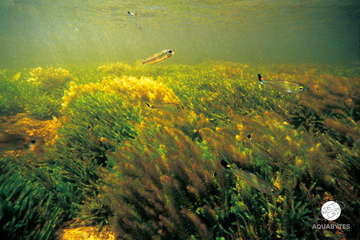Daphnia Magna are small (0.5-5mm) yet highly nutritious live food source for fish, offering a well-balanced profile that includes essential proteins, lipids, amino acids, and micronutrients. Typically, daphnia are around 50-60% protein, 20-30% fat, and rich in omega-3 fatty acids, also containing beneficial carotenoids like astaxanthin, that boosts pigmentation of fish. Daphnia’s natural composition mimics the diet of many wild aquatic species, making them a highly digestible and effective food source.
Under optimal conditions, daphnia can rapidly double in population within just a few days, providing a continuous and sustainable supply of live food. This ability to reproduce quickly reduces the reliance on buying commercial fish feed and supports consistent feeding without significant investment. It is so highly cost-effective in-fact; the initial setup requires minimal equipment and a small starter culture, and once established, it produces an abundant, self-sustaining food source with low maintenance. This makes daphnia an ideal choice for both hobbyists and commercial operations looking to reduce feeding costs while maintaining a high standard of nutrition for their aquatic populations.
- Enhanced immune responses, as evidenced by increased total protein content and albumin levels in the fish.
- Elevated antioxidant activity, especially higher at the 75% Daphnia diet.
- Improved intestinal structure, such as bigger villi (finger-like projections that line the intestine) for the 50% and 75% daphnia-meal groups. This indicates a bigger surface area for absorbing food and may help explain the higher growth rates.
Requirements for Culturing:
- Live Daphnia Magna (Click to Order)
- Distilled Water or Dechlorinated Tap Water
- Live Green Water (recommended) or yeast
- Container that can hold water
- Alkaline PH buffer or Baking Soda
- Artificial Light Source (E.g LED lighting)
What is Greenwater and Why Use it?
 Green water refers to water that contains a dense concentration of free-floating, microscopic algae—primarily phytoplankton. Despite its murky, pea-soup appearance, this water is not dirty or harmful; it's teeming with life. For aquarists, green water is a valuable biological resource, and for Daphnia and Moina, it’s their primary food source.
Green water refers to water that contains a dense concentration of free-floating, microscopic algae—primarily phytoplankton. Despite its murky, pea-soup appearance, this water is not dirty or harmful; it's teeming with life. For aquarists, green water is a valuable biological resource, and for Daphnia and Moina, it’s their primary food source.
What’s Actually in Green Water?
Green water is typically made up of single-celled algae such as Chlorella, Scenedesmus, and Euglena. These algae multiply rapidly in the presence of light, nutrients, and warm temperatures. When conditions are right—like in a still container with sunlight and fertilizer—they bloom and tint the water green. This cloudiness isn’t a sign of pollution; it’s an indication of a thriving micro-ecosystem.
These algae remain suspended in the water column, which is critical: Daphnia and Moina are filter feeders. They rely on suspended particles they can draw in and consume from the surrounding water. Unlike fish that eat discrete food particles, Daphnia must constantly process water to obtain nutrients—so a water column rich in microscopic algae is essential for their survival and growth.
Why Not Just Use Yeast or Spirulina?
While it's possible to feed Daphnia dry yeast / powdered spirulina, but these options come with drawbacks:
-
They can quickly pollute the water if overfed.
-
They settle to the bottom and rot if uneaten, creating a breeding ground for harmful bacteria.
-
They require daily manual feeding and careful measurement.
Green water, on the other hand, provides a continuous and self-sustaining food source that eliminates many of these risks. The algae reproduce naturally under light and nutrient conditions, meaning your culture is never without food—even if you forget to feed for a day or two. Because greenwater is alive and growing, it doesn't foul the water the way powdered foods do. There’s less organic waste, reducing the risk of culture crashes from ammonia spikes or bacterial blooms.
Step by Step Guide:

- Use a clean container with a preferably large surface area. A standard 20L bucket will suffice.
- Fill the volume of the container with distilled water or dechlorinated tap water before adding the live daphnia culture. Daphnia will not tolerate chlorine. The Daphnia will usually die if you add tap water directly into your container when making water changes.
- Check the pH of the water, as it should exceed PH 7, this is because daphnia reproduce quickly and use up calcium and minerals in the water to build their exoskeletons. If PH falls short, add alkaline PH buffer or baking soda until greater than PH 7 is reached.
- Position the container near the light source. Daphnia typically reproduce well with 12 hours of light and 12 hours of darkness a day. Be sure that any artificial light does not significantly heat the water in the container.
- Add a very small portion of green water or an alternative supplement until the water in the container is slightly cloudy.
- Repeat feeding after water clears up. This will depend on the density of your culture. The more dense, the more frequent the feeding.
Tips for Culturing Daphnia

- Change 20% of the water at least weekly; keep an eye on the ammonia levels. Remember to use dechlorinated or aged or bottled water as your replacement water. You can even use your old aquarium water, when you do a water change, as replacement water. If your daphnia culture is not reproducing quickly and thriving, you might want to do more frequent water changes.
- The daphnia culture doesn't need much oxygen to thrive. Containers kept outside with a large surface area don't need any aeration at all. Containers kept inside should have very light aeration (just enough to break the water surface). Too much aeration (bubbles) can kill off your culture
- Population Control: Daphnia reproduce quickly and can easily outgrow their food supply. When overcrowded, they’ll compete for algae, leading to stunted growth and high mortality. To prevent this, harvest Daphnia regularly to maintain a manageable population. A good rule of thumb is to harvest around 10-20% of the population every few days.
- Resource Depletion: If the Daphnia population grows too large, the algae they feed on may be consumed faster than it can regenerate. This can lead to nutritional deficiencies and a collapse of the culture. Ensure you have enough algae in the water or supplement with additional food if necessary.
- Contamination Risks: Contamination is a significant risk to Daphnia cultures, as it can quickly disrupt the balance of the ecosystem. Cleaning products, pesticides, and some fertilisers can be toxic to Daphnia. Always rinse equipment thoroughly before using it in the culture, and use non-toxic cleaners for maintenance.
- Cross-contamination: If you have other cultures, ensure you don’t transfer diseases or pests between them. Practice good quarantine and hygiene protocols to prevent cross-contamination.
Regular monitoring, good hygiene practices, and careful sourcing of materials will help prevent contamination and maintain a healthy Daphnia culture.




